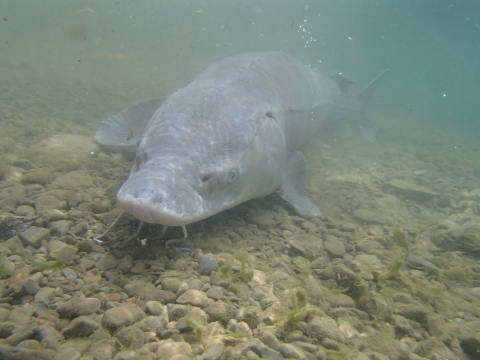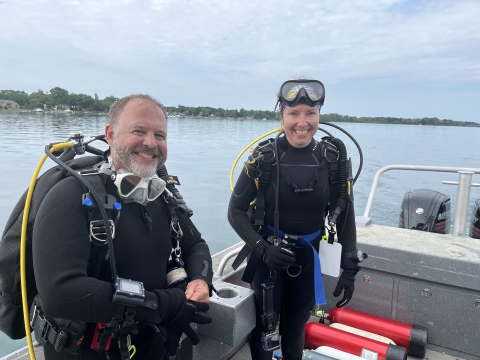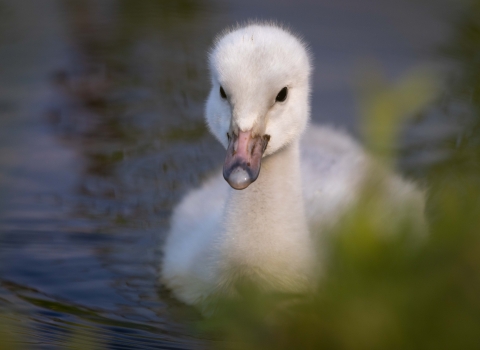Lake sturgeon could easily be mistaken for one of the mysterious, mythical lake monsters of the Great Lakes. Monstrously large fish, sturgeon can weigh up to 300 pounds and measure seven feet long! Seeing their bony body-armor and whisker-like barbels dangling from their snouts might make your knees shake, and as bottom-dwellers, they lend themselves well to tall tales.
But perhaps what they have most in common with fabled lake monsters, like Bessie of Lake Erie, Kingstie of Lake Ontario or Mishipeshu of Lake Superior, is that they are rare to spot. Even so, finding lake sturgeon is exactly what U.S. Fish and Wildlife Service biologists have set out to do. We’re helping New York State assess the size of the current sturgeon populations in Lake Erie and Lake Ontario to determine how the species is doing: thriving or barely surviving?
Once upon a time
Lake sturgeon cruised through waters when dinosaurs roamed the earth, and scientists estimate that Lake Erie once held hundreds of thousands of them. Habitat degradation, pollution, overfishing and dams all contributed to their steep decline in the 1800s. Eventually, they were nearly impossible to find.
Even as conditions have improved, sturgeon populations are slow to recover. Females reach sexual maturity in their 20s and do not spawn every year, so it can take decades to see a rebound.
In 1983, New York added lake sturgeon to their list of threatened species and developed recovery plans. Their goal is to meet population benchmarks — more than 750 spawning adults and greater than three naturally reproduced year classes (fish born in the same year) in a five-year period — in at least six of the seven management units that span Lake Erie, Lake Ontario and Lake Champlain. With years of effort, working in partnership with multiple agencies, they’re getting close.
Tracking lake giants
In eastern Lake Erie, Service biologist Dr. John Sweka and his team have been using acoustic telemetry to track lake sturgeon movement and estimate population size.
Working collaboratively with partners monitoring other sections of Lake Erie, they deploy receivers along the lake bottom that record each transmitter-equipped fish’s location as it swims by. This information is uploaded to a shared database.
“We found that most of the sturgeon tend to hang around Buffalo year-round,” Sweka said. “We did have a couple individuals that migrated across the lake, but the majority returned to their spring spawning grounds at the headwaters of the upper Niagara River.”
Learning that sturgeon have an affinity for their birthplace affirmed counts — they weren’t inflated by wanderers from other areas of the lake. The biologists estimated 900 adults in eastern Lake Erie, which exceeded New York’s goal. Other teams found that population objectives were met in western Lake Ontario and along the upper and lower St. Lawrence River as well.
Do they exist?
In western Lake Ontario, data collected since 2010 show a healthy adult lake sturgeon population, but one that is aging — most were born 20-30 years ago.
This leads to questions about natural reproduction. Are adults reproducing, and if so, are their offspring surviving?
Sturgeon in Lake Ontario and Lake Erie share the Niagara River but are divided into two unique populations by the jaw-droppingly large Niagara Falls. For three years, Service biologist Dr. Dimitry Gorsky has been trying to capture juvenile lake sturgeon in both sides of the river, with zero luck.
“We may not have any juveniles anywhere. That’s what we’re trying to figure out,” Gorsky said.
Last summer, he coordinated a team of 15 divers to train in swift water — the preferred habitat of juvenile sturgeon — in hopes of spotting the young fish. Though the divers didn’t see any juveniles, the exercise uncovered a potential clue to explain their absence: invasive zebra mussels and their shells were littered across the river bottom.
“We think this has probably led to some habitat degradation, because they’re sharp and don’t create a good substrate for some of the invertebrates that the juveniles would eat,” Gorsky said.
Though the team hasn’t caught any juveniles in the river yet, they’re optimistic. In 2013, they saw mature females coming into the lower Niagara River from Lake Ontario to spawn and found lake sturgeon eggs there for the first time. This spring, those offspring should be turning 10 years old — the age and size when they become easier to catch. If they survived, this is the year those fish might appear in surveys!
A living legend
As lake sturgeon near New York’s recovery goals, we’re hopeful they will continue to delight those who glimpse their large bodies meandering throughout the Great Lakes. And though they share many similarities with mythical lake monsters, one main difference is that the mighty, resilient lake sturgeon will live on in our waters, not only through stories or in our imaginations. With care, they’ll be living legends for millions of years more.







